Vintage style interior design is making a remarkable comeback, captivating homeowners who crave a sense of nostalgia and timeless charm. As we approach 2025, this trend continues to gain momentum, inspiring both seasoned designers and those new to home styling.
This comprehensive guide will show you how to blend vintage style interior design seamlessly with contemporary living spaces. Discover the history behind the look, explore essential design elements, and learn step-by-step methods to create a home that feels both classic and current.
Get ready to transform your space by exploring trending vintage looks, expert sourcing tips, and professional advice. Embrace the unique character and lasting appeal that vintage style brings to modern homes.
Understanding Vintage Style Interior Design
Vintage style interior design has become a defining trend for those seeking a home that feels both timeless and unique. This approach carefully curates the best of past decades, creating inviting and character-filled spaces that reflect personal taste and history.
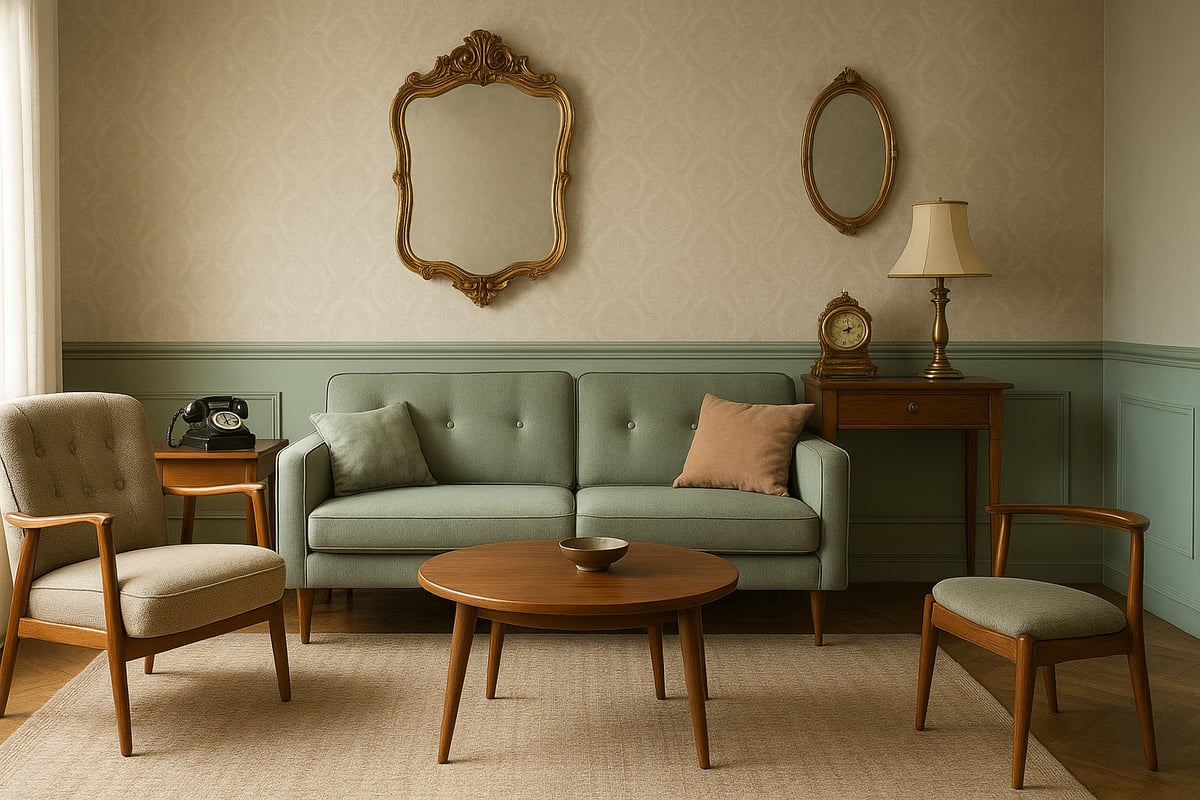
Defining Vintage Style
Vintage style interior design refers to decor and furnishings that are typically between 20 and 100 years old. Unlike antiques, which are generally classified as being over 100 years old, or retro, which often imitates old styles with new production, vintage pieces are authentic items from the past. The charm of vintage style interior design lies in its sense of nostalgia, visible craftsmanship, and the natural patina that develops over time. Influences from previous eras shape today’s designs, making each interior feel both historic and fresh.
Historical Influences and Popular Eras
The roots of vintage style interior design stretch across several influential decades, from the bold patterns of the 1920s Art Deco movement to the clean lines of Mid-century Modern in the 1950s and the playful shapes of the 1980s. Each era brought distinct aesthetics, such as Eames chairs in the 1950s or G-Plan sideboards from the 1960s. The growing interest is evident, with Google Trends showing a steady rise in "vintage interior" searches since 2022. For those drawn to the elegance and glamour of Art Deco, the Art Deco Furniture Collection offers inspiration and showcases iconic pieces from this influential period.
Why Vintage Style Appeals to Modern Homeowners
Vintage style interior design continues to gain popularity for several reasons. Many homeowners value sustainability and upcycling, choosing vintage items to reduce environmental impact. There is also a strong emotional connection to the past, as vintage pieces often carry family stories or evoke memories. Unlike mass-produced decor, vintage style interior design allows for truly personalized interiors. According to Statista in 2023, 64% of millennials now prefer vintage or secondhand furniture, highlighting the growing demand for these unique finds.
Core Elements of Vintage Interiors
Key materials in vintage style interior design include warm woods, gleaming brass, plush velvets, and natural rattan. Patterns such as florals, geometrics, and damask frequently appear on wallpapers, textiles, and rugs. Popular color palettes range from muted pastels like blush and sage to rich jewel tones. Accessories play an important role, with ornate mirrors, rotary phones, and classic clocks adding finishing touches that complete the vintage look.
- Materials: wood, brass, velvet, rattan
- Patterns: florals, geometrics, damask
- Colors: muted pastels, jewel tones
- Accessories: mirrors, rotary phones, clocks
Common Misconceptions
There are several misconceptions about vintage style interior design. Some believe it results in cluttered or outdated spaces, but a thoughtful approach balances old and new elements. Vintage style works well in homes of any size, from compact apartments to spacious houses. Another myth is that vintage always comes with a high price tag, when in reality, many pieces are affordable with careful sourcing. The key is to avoid creating a "museum" feel and instead aim for a harmonious blend that feels both lived-in and stylish.
Essential Elements of Vintage Style for Modern Homes
The foundation of a successful vintage style interior design lies in mastering the essential elements that bring nostalgic charm into modern spaces. By thoughtfully selecting furniture, colors, textiles, lighting, and blending techniques, you can create a home that feels both timeless and inviting. Understanding these core components will help you achieve balance and authenticity in your vintage style interior design journey.
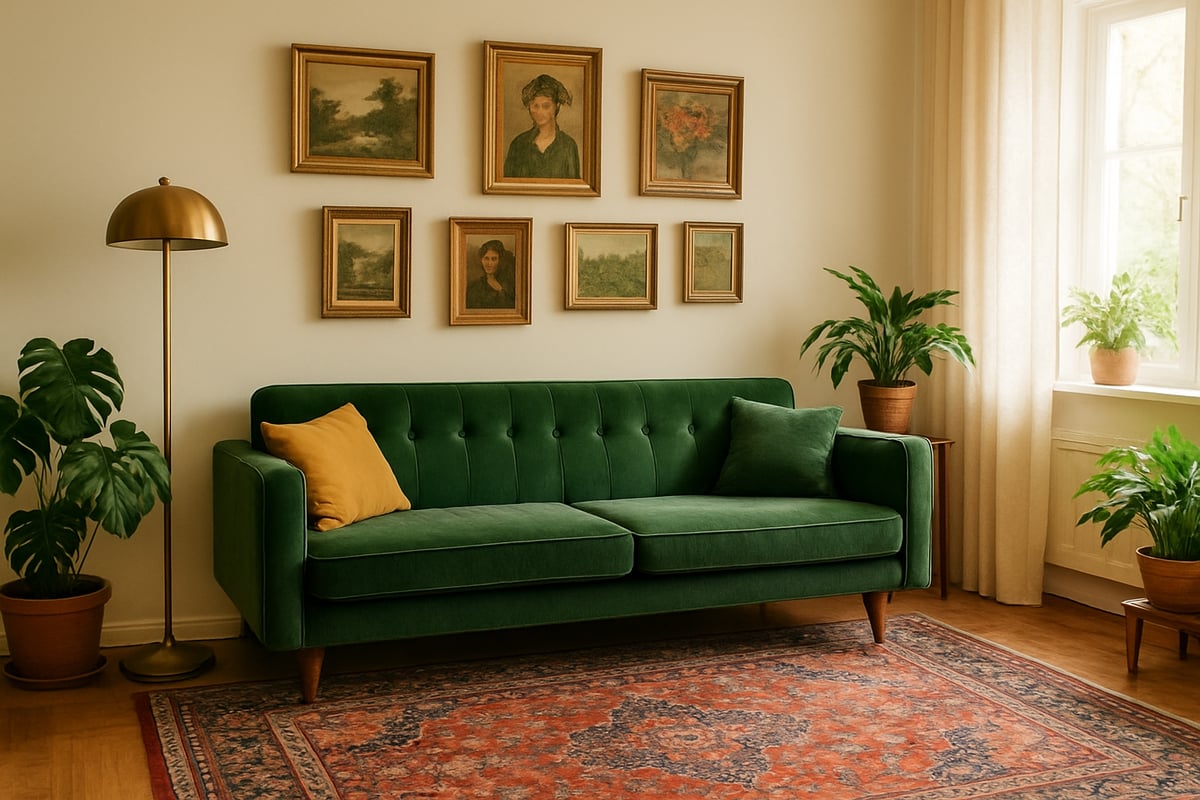
Furniture Selection and Placement
Choosing the right furniture is crucial for vintage style interior design. Start with iconic pieces such as 1960s sideboards, tufted armchairs, and classic credenzas. Mixing eras, like pairing a mid-century sofa with a contemporary coffee table, adds personality and prevents the space from feeling dated.
Consider placement for both flow and function. Place a vintage sideboard near the entryway for storage and a welcoming statement. Use an armchair as a reading nook anchor. Remember, vintage style interior design thrives on curated contrasts, so do not hesitate to integrate different shapes and finishes.
Vintage-Inspired Color Schemes
Color sets the mood in vintage style interior design. For 2025, trending palettes include sage green, mustard yellow, and blush pink, each evoking specific eras. Use muted pastels for a soft 1950s vibe or jewel tones for an Art Deco feel.
Contrast vintage hues with modern neutrals like crisp whites or soft grays to keep the look fresh. According to Pinterest, searches for "sage green interiors" are predicted to rise by 30 percent in 2025, making it an ideal choice for those embracing vintage style interior design.
Textiles and Patterns
Textiles play a vital role in vintage style interior design. Opt for rich fabrics such as velvet, linen, chenille, and chintz. Layering different textures adds depth and comfort, while pattern mixing brings visual interest.
Combine florals with stripes, or geometrics with solids, for a collected feel. For example, a vintage Persian rug can ground a minimalist room and introduce both color and history. Do not shy away from mixing new and old textiles to keep the space dynamic and true to vintage style interior design.
Lighting and Accessories
Lighting and accessories are the finishing touches in vintage style interior design. Statement pieces like crystal chandeliers, Tiffany lamps, and globe pendants add drama and period character.
Decorate with vintage clocks, ornate mirrors, and classic ceramics for authenticity. Incorporate vintage art and wall décor to personalize each room. A recent Houzz survey found that 47 percent of homeowners added vintage lighting in 2024, confirming the growing appeal of these timeless accents in vintage style interior design.
Blending Vintage with Modern Elements
Achieving harmony in vintage style interior design means balancing old and new. The 80/20 rule is a helpful guide: use either 80 percent modern and 20 percent vintage, or vice versa, to avoid a "museum" effect. Highlight vintage pieces as focal points or accents, and update finds with new upholstery or a fresh coat of paint.
For inspiration on how to successfully mix eras, explore the Eclectic Interior Collection, which showcases creative ways to blend vintage treasures with modern design. This approach ensures your vintage style interior design feels curated, functional, and uniquely yours.
Step-by-Step Guide: Incorporating Vintage Style into Modern Homes
Blending vintage style interior design with your modern home may seem daunting, but with a clear plan, you can achieve a timeless, curated look. This practical guide breaks down the process into seven manageable steps, ensuring your space feels both nostalgic and fresh.
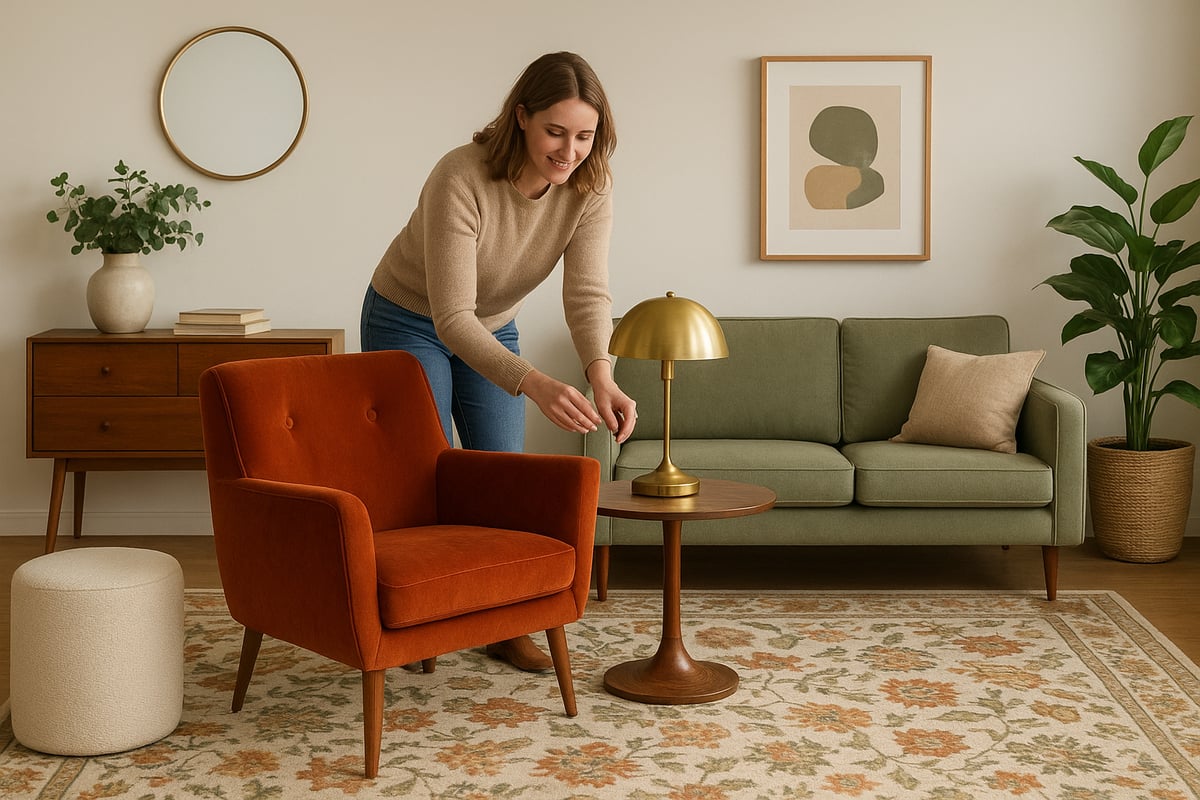
Step 1: Assess Your Space and Identify Opportunities
Begin your journey into vintage style interior design by evaluating your current space. Look at the size and shape of each room, noting natural lighting and architectural features like molding or hardwood floors.
Identify focal points where vintage pieces can shine, such as a fireplace mantel or entryway. Consider how your existing décor might interact with vintage elements so that the transition feels seamless.
A simple checklist can help:
- What are your room’s strengths?
- Where would vintage accents add character?
- Are there areas that need more warmth or texture?
Taking inventory at this stage sets a strong foundation for the rest of your vintage style interior design project.
Step 2: Define Your Vintage Inspiration
Choosing your inspiration is crucial for cohesive vintage style interior design. Decide if you’re drawn to a specific era, such as the elegance of the 1930s or the boldness of the 1970s.
Create a moodboard with images, colors, and textures that capture your vision. Online platforms like Pinterest and Instagram are invaluable for gathering ideas and visual references.
Ask yourself:
- Which decades or styles resonate most?
- Do you prefer a mix of eras or a focused aesthetic?
- What colors and materials evoke nostalgia for you?
This clarity ensures your vintage style interior design choices feel intentional and personalized.
Step 3: Source Authentic and Reproduction Pieces
Sourcing is a key step in vintage style interior design. Explore local thrift stores, flea markets, antique shops, and online marketplaces for unique finds.
When shopping, check for quality markers like solid wood construction, original finishes, or maker’s marks. Decide if you want authentic vintage or high-quality reproductions, weighing factors like budget and longevity.
For example, you might find a 1970s teak sideboard on Facebook Marketplace that fits your vision perfectly. Remember, a mix of genuine and reproduction pieces can still achieve an authentic look in vintage style interior design.
Step 4: Integrate Vintage Elements Gradually
Introduce vintage style interior design elements slowly to avoid overwhelming your space. Start with smaller items such as lamps, textiles, or wall art before moving to larger furniture pieces.
Layering is key. Place a vintage mirror above a modern console or swap out basic cushions for patterned, retro-inspired ones. Observe how each addition impacts the room’s atmosphere.
This gradual approach lets you adjust as you go, building confidence in your vintage style interior design decisions while keeping your home feeling balanced.
Step 5: Mix and Match with Modern Décor
A successful vintage style interior design blends old and new for a dynamic, livable space. Use the 80/20 rule: dedicate 80% of the room to one style, and 20% to the other for harmony.
Try pairing a mid-century armchair with a sleek, modern coffee table or combining vintage artwork with minimalist shelving. Use modern lighting with vintage-inspired shades for a fresh twist.
Experiment with contrast and balance, but always ensure comfort and functionality remain central in your vintage style interior design scheme.
Step 6: Personalize and Accessorize
Personal touches make your vintage style interior design truly unique. Display collections like vinyl records, vintage cameras, or heirloom books for added character.
Rotate accessories seasonally to keep the look fresh. Incorporate items with sentimental value, blending them with curated finds for a layered, lived-in feel.
For finishing touches, explore a curated selection of decor accessories for vintage homes to complement your space and enhance its personality. This step ensures your vintage style interior design reflects your story and style.
Step 7: Maintain and Restore Vintage Finds
Caring for your treasures is the final step in vintage style interior design. Regularly dust and clean delicate materials using appropriate methods, such as gentle wood polish or fabric cleaner.
Tackle minor repairs yourself, like tightening screws or touching up finishes, but consult a professional for more complex restorations. Proper maintenance preserves both the beauty and longevity of your vintage pieces.
By following these steps, you’ll enjoy a vintage style interior design that feels timeless, welcoming, and uniquely yours.
Trending Vintage Styles and Design Ideas for 2025
The world of vintage style interior design is set to make a bold statement in 2025. As homeowners seek spaces that blend nostalgia with modern sensibilities, vintage-inspired looks are evolving to meet contemporary tastes. This year, expect to see a thoughtful mix of eras, sustainable choices, and creative approaches for rooms of all sizes.
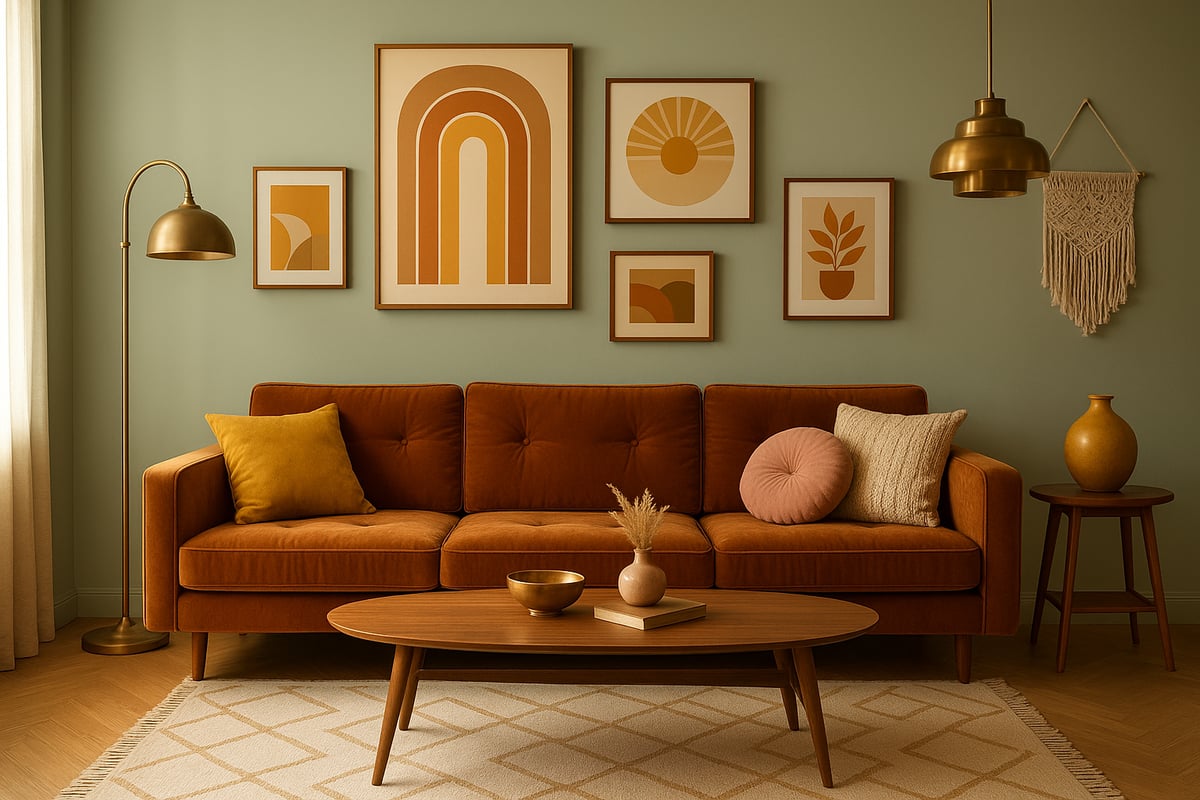
Popular Vintage Trends for 2025
2025 is witnessing a revival of earthy 1970s palettes, bohemian influences, and the glamorous sparkle of Art Deco. Designers are pairing rich velvet fabrics with metallic accents and introducing bold, Memphis-style color pops from the 1980s for a playful touch. Notably, “boho vintage” mentions have surged by 22% on Instagram this year.
Expect to see tramp art and iron décor gaining traction, as highlighted in Vintage Trends 2025: 7 designs to have on your radar. These elements, when integrated into vintage style interior design, create a layered, collected look that feels both fresh and timeless.
Room-by-Room Vintage Inspiration
Transforming your home with vintage style interior design means tailoring each room to reflect the era and vibe you love. In the living room, velvet sofas and curated gallery walls set a sophisticated tone. Kitchens come alive with retro appliances and enamelware, while bedrooms feature tufted headboards and antique dressers for a cozy, elegant retreat.
For bathrooms, clawfoot tubs and ornate mirrors lend old-world charm. By focusing on key pieces in each space, you ensure the vintage aesthetic feels intentional rather than overwhelming.
- Living room: velvet sofas, gallery walls
- Kitchen: retro appliances, enamelware
- Bedroom: tufted headboards, antique dressers
- Bathroom: clawfoot tubs, vintage mirrors
Combining Vintage with Sustainability
Sustainability is at the heart of modern vintage style interior design. Upcycling old furniture not only reduces waste but also brings unique character to your home. Eco-friendly materials, such as reclaimed wood or organic textiles, are increasingly popular with designers.
According to Elle Decor, 58% of interior designers recommend upcycling as a go-to strategy. Choosing vintage means you’re investing in pieces with a story, supporting a circular economy, and minimizing your environmental footprint.
- Upcycle furniture to reduce waste
- Select eco-friendly finishes and paints
- Shop local vintage markets to cut down on shipping
Vintage Style for Small Spaces
Vintage style interior design is not limited to sprawling homes. In fact, small spaces benefit from clever vintage finds that maximize function and style. Space-saving pieces like nesting tables or folding chairs are practical and charming.
Mirrors and light color palettes create a sense of openness, while compact items such as 1950s bar carts or streamlined credenzas bring character without crowding. The key is to select a few standout items that make a big impact.
| Solution | Vintage Example | Benefit |
|---|---|---|
| Nesting tables | 1960s teak sets | Flexible surface space |
| Mirrors | Art Deco wall mirrors | Reflect light, add depth |
| Bar carts | 1950s chrome or brass | Mobile storage, visual pop |
Common Mistakes to Avoid
When embracing vintage style interior design, it’s easy to get carried away. Overcrowding a room with too many vintage pieces can make it feel chaotic rather than curated. Ignoring scale and proportion may disrupt balance, while sacrificing comfort for style leads to impractical spaces.
Avoid mismatching eras without a unifying theme, and always blend vintage with your home’s overall design. Remember, thoughtful integration creates harmony and lasting appeal.
- Don’t overcrowd with vintage items
- Respect scale and proportion
- Prioritize comfort and function
- Ensure cohesion with your home’s style
Sourcing and Shopping for Vintage Decor
Sourcing unique pieces is essential for achieving an authentic vintage style interior design. With the right approach, you can uncover treasures that fit your vision and budget. The best places to search are local antique shops, estate sales, and specialty vintage stores. Pop-up markets and community resources like Facebook Marketplace or Craigslist also offer surprises. For those seeking premium finds or designer pieces, online auctions and platforms such as The 1stDibs Guide to 2025 Interior Design Trends provide access to a global selection and highlight current vintage trends.
Where to Find the Best Vintage Pieces
Start your vintage style interior design journey by exploring nearby antique stores, estate sales, and vintage pop-ups. These venues often have knowledgeable staff and unique inventory. For rare or high-end items, online auction sites like eBay and 1stDibs are invaluable. Community-driven platforms such as Facebook Marketplace or Craigslist can yield unexpected gems at great prices. Always check for local vintage fairs or design events, as these often feature curated selections from trusted dealers.
Tips for Authenticity and Quality
When shopping for vintage style interior design, always inspect each piece for authenticity. Look for maker’s marks, labels, or stamps that indicate origin and age. Assess the structural integrity by checking joints, finishes, and any signs of repair. Original finishes and minimal restoration often add to a piece’s value. If possible, ask about provenance to understand the item’s history. Negotiating fairly and understanding market value will help you secure quality pieces without overpaying.
Budget-Friendly Vintage Shopping
Embracing vintage style interior design does not have to be costly. Shop during off-peak seasons for better deals and consider buying in bulk from estate sales. DIY restoration projects, such as repainting or reupholstering, can transform affordable finds into standout pieces. Repurposing items, like turning vintage suitcases into side tables, adds character and saves money. Remember, patience and persistence often lead to the best bargains and most distinctive decor.
Online Resources and Cautionary Advice
Online shopping expands your access to vintage style interior design, but caution is key. Use trusted marketplaces with strong reputations and read reviews before purchasing. Verify authenticity through detailed photos, item descriptions, and seller ratings. Be wary of reproductions or misleading listings. Always check shipping policies and returns, especially for fragile or high-value items. For more on the revival of retro styles and what to look for in 2025, see 5 Design Trends Making a Comeback in 2025, According to Designers.
Expert Tips and Resources for Achieving the Perfect Vintage Look
Drawing on expert guidance is essential for mastering vintage style interior design. The following tips and resources will help you create cohesive, stylish, and timeless interiors that reflect your personality while staying true to vintage inspiration.
Advice from Interior Designers
Interior designers recommend prioritizing both function and style in vintage style interior design. Begin by layering textures and patterns to give rooms depth and visual interest. Combine velvet, linen, and rattan for a rich tactile experience. Use patterned textiles, such as floral or geometric cushions, to introduce subtle nostalgia.
To maintain a cohesive flow, repeat key colors or motifs throughout your home. Pay attention to how furniture placement affects movement and comfort, ensuring vintage pieces enhance rather than overpower the space. Remember, vintage style interior design is about creating harmony, not clutter.
DIY Vintage Projects and Customization
Personalizing your space through DIY projects is a popular approach in vintage style interior design. Try painting or distressing old furniture to highlight its character. Reupholster vintage chairs and sofas with contemporary fabrics for a fresh look. Create custom wall art using vintage prints or repurposed frames for a unique touch.
For more creative inspiration and project ideas, explore Home Decor Project Ideas 2025, which features vintage-inspired trends and hands-on guides. These projects make vintage style interior design accessible, budget-friendly, and highly personal.
Leveraging Design Tools and Courses
Digital tools are invaluable for planning vintage style interior design projects. Use 3D modeling software to experiment with furniture layouts and color schemes before committing. Online courses can teach restoration techniques, upholstery skills, and styling tricks, giving you confidence to tackle vintage transformations.
Moodboarding is another essential step. Collect images of your favorite eras, fabrics, and furniture to visualize how elements will work together. This method streamlines decision-making and keeps your vintage style interior design vision clear and focused.
Staying Inspired and Up-to-Date
Stay current with vintage style interior design by following influential designers, blogs, and social media accounts dedicated to the look. Visiting museums and design exhibitions can spark new ideas and deepen your appreciation for historical styles.
Interior design magazines and newsletters are valuable for tracking trends and emerging ideas. For a preview of what is coming in 2025, check out The Interior Design Trends to Know in 2025—And What's on Its Way Out, which highlights the resurgence of Art Deco, drapery, and bold jewel tones. Staying inspired ensures your vintage style interior design remains fresh and relevant.
As you’ve discovered throughout this guide, blending vintage style with modern interiors is all about thoughtful choices, personal expression, and a bit of creative confidence. If you’re inspired to take your passion for design further—whether you want to reimagine your own space or build professional skills—why not deepen your expertise? You can start your journey into the world of interiors with guidance tailored for modern homes and timeless touches. Explore foundational principles, practical techniques, and creative ideas to bring your vision to life by taking the next step: Get started with Interior Design







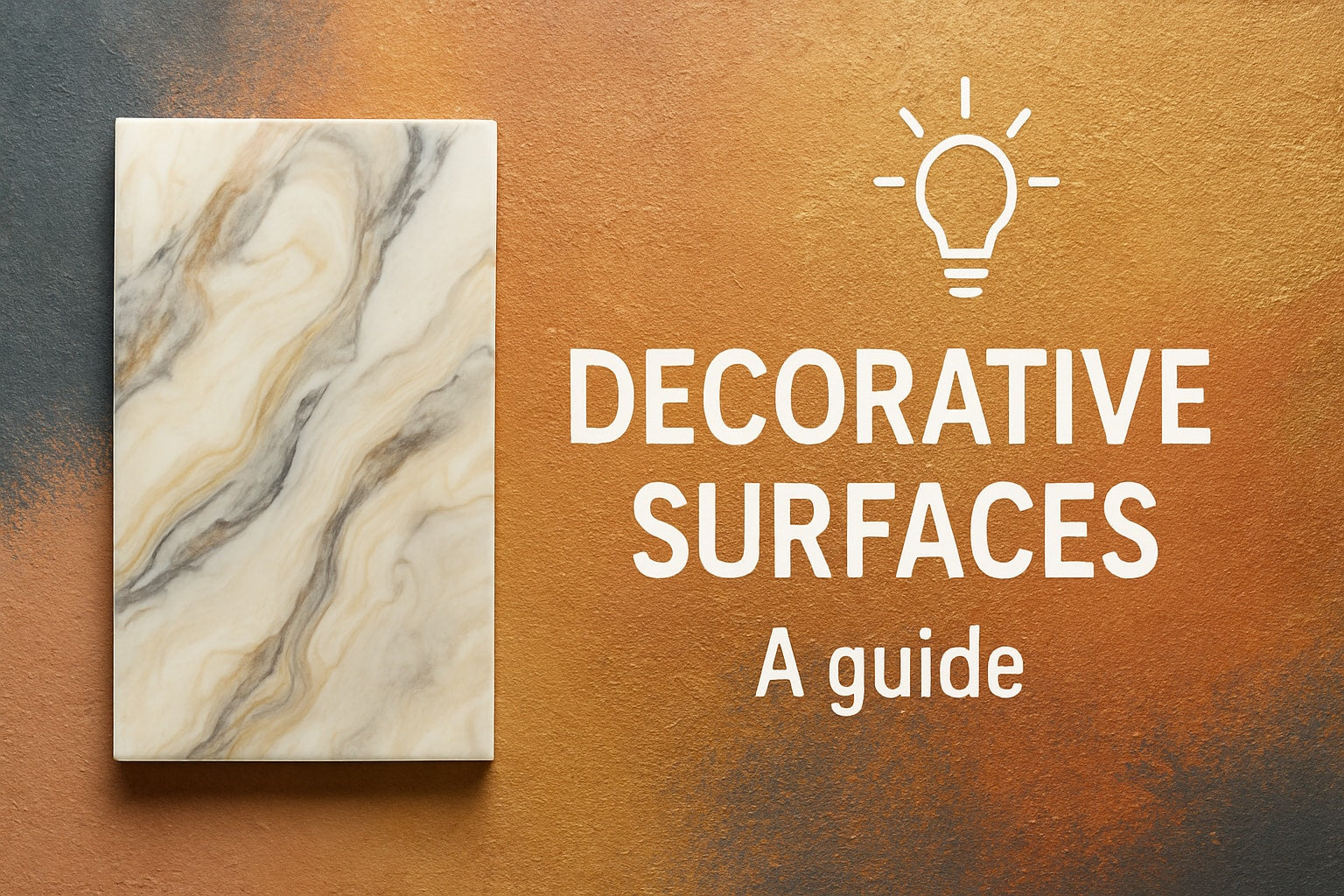
Share:
New Build House Interior Design Trends 2025
Stunning House Interior Theme Ideas for 2025 Homes